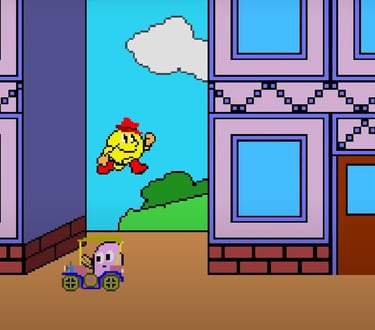
The Fairyland Story
Taito/1985/Arcade
Taito’s Bubble Bobble might be the company’s preeminent platformer, but it’s predated by the equally quirky The Fairyland Story, a game that set the template not only for the Bubble-happy platformer, but arguably, the entire genre.
The game features only the barest of stories—as the squat witch Ptolemy, players must survive 101 rounds of ever-approaching, encroaching foes before facing-off against an enormous dragon at the very end. Victory means defeating a stage’s given enemies; the witch has the unique power of transforming the poor fiends into oven-baked cakes. She can then push/drop these hulking desserts onto other baddies, flattening them in the process and earning extra points. Indeed, there’s an unseemly edge to the superficially cute proceedings—the “bad guys,” from wizards to even, apparently, Christian bishops, die by the (baker?) dozens at Ptolemy’s hex-flexing wand, making one wonder who’s really the true villain.
Darker sides aside, the game is undeniably lighthearted in its outward pretensions, boasting bumbling foes with distinct, cartoony personalities. Pig soldiers show obvious consternation when a comrade bumps into them, and the normally stoic golems will freak at the screen when ensnared by a giant worm. Ptolemy is equally expressive, showing a far wider range of emotions than was normal for games of the time. Whether scorched by fire or roped by a ravenous worm, the player knows immediately what the witch is feeling. The game is almost like playing a cartoon…or rather, a single-panel comic strip.
Stages are likewise surreal, shifting cascades of platforms between the interiors of castles to frontier-style forts to even the hollows of giant desserts. But the goofiness belies a trollish, even spiteful difficulty that soon consumes the later stages. Early on, players can simply take the high ground, luring foes upward in single-file style for some easy, fish-in-a-barrel ensorcelling. But the somewhat stiff, unyielding controls soon become a problem, making the precise jumps required of the game’s latter fifty stages an onerous affair. The concluding stages are especially esoteric, forcing players to endure a gamut of mean, cryptic puzzling. And with the continue option cruelly removed at Stage 99, one wonders if anyone reached the game’s denouement back in faraway 1985. Here, the magic of modern emulation saves the day, bestowing endless save states on anyone actually intending to defeat the dragon.
The Fairyland Story never received much attention in the years following its release. It got few ports, no sequel, and just the barest of references in other games, most notably Rainbow Islands and Don Doko Don. It certainly deserved a follow-up, but the reason it didn’t is probably the fault of its beloved successor, Bubble Bobble. This was the game that became synonymous with the genre—a franchise still paying dividends decades later. Much like how Alex Kidd got replaced by Sonic over at Sega, the witch got switched with two dragons…a mascot dropped for a bubbly twosome.
But as video games become ever-more expressive and stylized, Ptolemy’s adventure seems less and less trivial. Beyond revitalizing an entire genre, her title's cartoony, off-color tone is now a gaming cliche, seeded in everything from Rod-Land to Worms to Hi-Fi RUSH—not a bad legacy for such an unassuming witch. The Fairyland Story might not be a household name, but its legacy hides in plain sight.—D
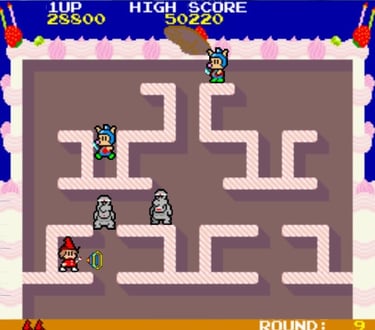


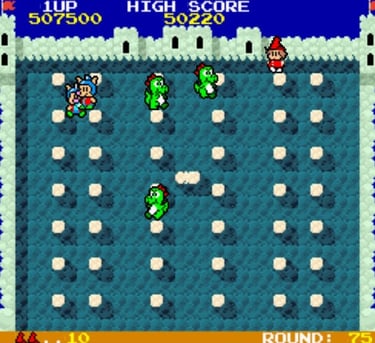

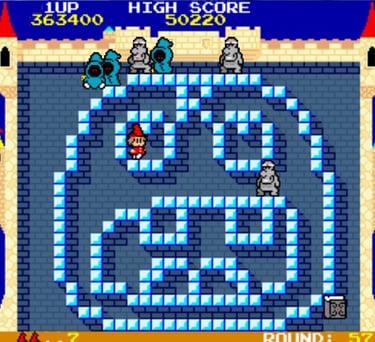
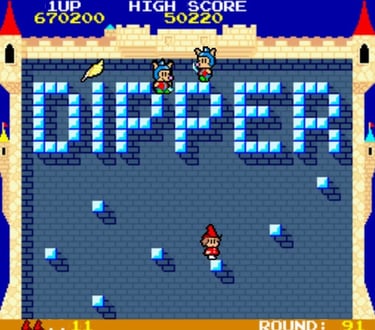

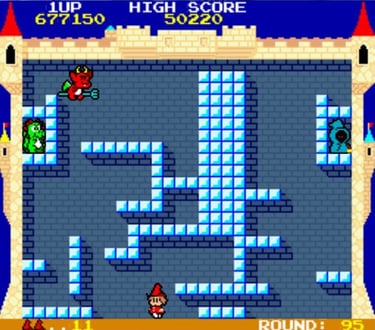





The Fairyland Story sets its stages in a variety of settings. Seems somewhat subversive turning a pig into a cake...within the walls of a giant cake.
Whether for humor or for a want of better designs, the stage layouts get increasingly "meta."
This stage is one of those--a level in which the solution isn't especially clear.
The worm...offers the game an ever lurking, primordial horror, proving dangerous to both hero and foe alike.
Ptolemy isn't the only soul with magical powers. Here, she gets blasted back by an enemy wizard, now shrunk and stuffed within her hat.

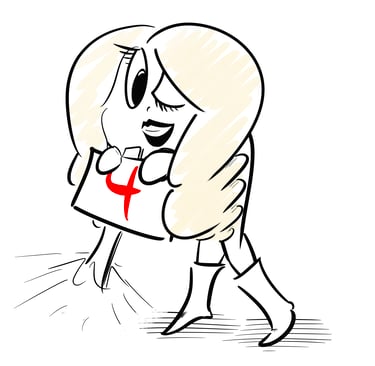
The Fairyland Story changed the single-screen platformer much like Pac-Land changed the scrolling platformer (the latter inspiring even the likes of Super Mario Bros.)
Contact: lostnostalgiaproductions@gmail.com
Website: www.lostnostalgia.com
Like what we're doing? Please consider throwing us a dollar into our Patreon page's tip jar!



